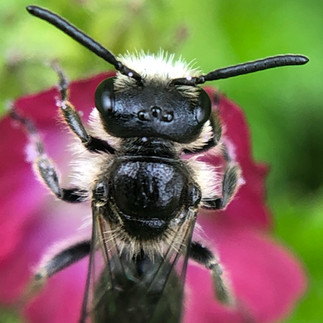WHAT CAN iNATURALIST DO FOR PRIORITY ECOSYSTEMS CONSERVATION IN A MEGADIVERSE DEVELOPING COUNTRY?: The fog oasis of Lima as an example
- Antonio W. Salas
- Jun 28
- 4 min read
Updated: Jun 29
Opportunities for sustainable development with citizen science.


Around the world, many fragile ecosystems—such as wetlands, cloud forests, dry forests, and coastal relics—face increasing threats due to climate change, urban expansion, and unsustainable land use. Despite their ecological importance, these ecosystems often receive little attention from national and regional governments, remaining outside of conservation, research, and ongoing monitoring priorities.
Lomas de Lima: Where the sky kisses the earth.
A representative example is found on Peru's central coast: the Lomas de Lima (called fog oasis in english), an ecosystem that is seasonally activated by the condensation of moisture from the fog that comes from the sea.
This ecosystem occurs seasonally, between the months of May and September, in the form of scattered patches distributed along the divide formed, between the arid landscape of the coastal desert and the Andes. Despite their simple appearance, these hills harbor remarkable biological diversity, including endemic species that only exist in a few very specific areas and that require further study to be properly identified and protected.
Virtual Conversation "La Lima de las Lomas"
During the Virtual Conversation "La Lima de las Lomas", held on Friday, June 13, 2025, and organized by the Club de Observadores de Aves del Perú Lima (COAP-Lima), the talk "Participatory Conservation of the Coastal Lomas of Peru with iNaturalist" was presented, which showed how the use of this platform can provide valuable information for the management of these ecosystems, integrating citizen participation with the support of scientific knowledge.
The talk was presented by biologist Antonio W. Salas, president of the iNaturalist National Committee in Peru, a coordinating group made up of eight organizations that promote the use of this application in the country.
The exceptional species richness of a seasonal ecosystem.
The presentation shared specific cases, such as that of the emblematic Amancaes flower (Ismene amancaes), whose observations on iNaturalist have allowed for mapping its current presence in various sectors of Lima, including areas not formally protected.
The case of the species Nolana humifusa was also presented, a wild plant whose distribution pattern helps us understand how certain species take advantage of the unique conditions offered by the humidity of fog during the winter months.
Beyond individual records, the true potential of iNaturalist is revealed when analyzing sets of observations from multiple species. For example, by simultaneously recording a flowering plant, the insects that visit it, birds that feed in the same area or use that habitat for nesting, and other species that coexist in the same place, we begin to build a more complete picture of the ecological interactions that sustain the ecosystem.
Ecological Interactions in the Lomas
In Lomas ecosystems, relationships between species can be studied, such as:
Cross-pollination of certain wild plants by native bees or local butterflies.
Seed dispersal by birds or rodents that feed on fruits and contribute to plant regeneration.
Competition between plant species, which influences how vegetation patches are structured in different microhabitats.
The presence of indicator species, which allow us to assess the health of an area or detect impacts due to urban pressure or the presence of exotic species.
Opportunities with iNaturalist for Conservation of the Lomasby local organizations
For local authorities, non-governmental organizations, and community groups seeking to protect these spaces, having this information contributes to:
Improving our understanding of the ecosystem.
Providing a technical and georeferenced basis for decision-making, for example, to delimit priority areas for conservation and justify the creation of buffer zones.
Planning restoration actions, or even responding to specific threats such as urban expansion, invasions, or fires.
During the event, the audience showed particular interest in learning whether iNaturalist had already been used in local management processes with community participation. Successful experiences were mentioned in Mexico, where municipal governments and citizen groups have worked together using the platform to monitor urban natural areas, design conservation plans, and strengthen environmental education on a participatory basis.
The iNaturalist app as a citizen science tool for conservation.
In short, iNaturalist offers much more than a collection of records. It is a living tool that, when used strategically, can transform the way biodiversity is understood and managed in ecosystems as special as coastal hills.
It is time for decision-makers and local organizations to consider the potential of this platform as a key ally for evidence-based, citizen-led conservation.

Lomas de Lima project on iNaturalist
The Lomas de Lima umbrella project compiles historical contributions to the main areas delimited to date. The project can be accessed at this link. https://www.inaturalist.org/projects/lomas-de-lima-paraguas
To date, more than 550 species have been documented, with the papaya (Vasconcellea candicans), a species of wild papaya, being the most frequently observed. Next in line are the hill lizard (Microlophus tigris) and the sand owl (Atehene cunicularia).
Fourth, the species considered emblematic of this ecosystem, the amancaes flower (Ismene amancaes), is widely represented in regional art and culture for its beauty and distinctive behavior, as it provides a spectacle of explosive flowering simultaneously with the beginning of the wet season, covering the hillsides in yellow.
If you have the opportunity to visit Las Lomas, now you know that with your photos, you can contribute to understanding their richness of species and their ecological interactions, thus contributing to their conservation.
"Lomas de Lima, a green whisper in the coastal fog, a refuge of life that springs up where the desert is silent."
My greatest thanks to ellky, Ellky Arteta Paredes, a professional tour guide who gave me the opportunity to explore the Pucará hills, the photos of which are featured in this post. If you'd like to learn more about this hidden paradise south of Lima, you can contact her at the link in her username.
Loma Pucara project can be visited by following the link.
The Comité Nacional de iNaturalist en el Perú It is made up of organizations Alianza Internacional para la Conservación Ambiental, Asociación Pro Fauna Silvestre – Ayacucho, César’s Tours, Círculo de Investigación de Ornitología CIO-UNALM, Club de Observadores de Aves del Perú COAP, Denver Zoo, La Rana Luchín y Naturalista Perú. This Committee has been coordinating Peruvian participation in events such as City Nature Challenge, the Great Southern Bioblitz and The Home River Bioblitz.


















Hey Antonio, Looks like Peru has a strong iNaturalist and citizen science community its truly great to see.